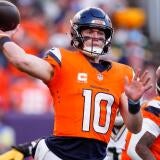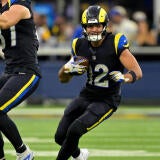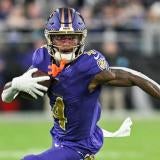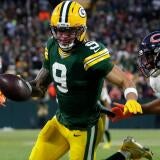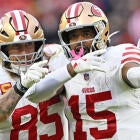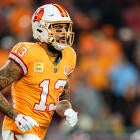2020 Fantasy Football Draft Prep: Rookies are the key to 2020 re-draft leagues
The case for rookies playing a major role in deciding who wins your 2020 Fantasy league.
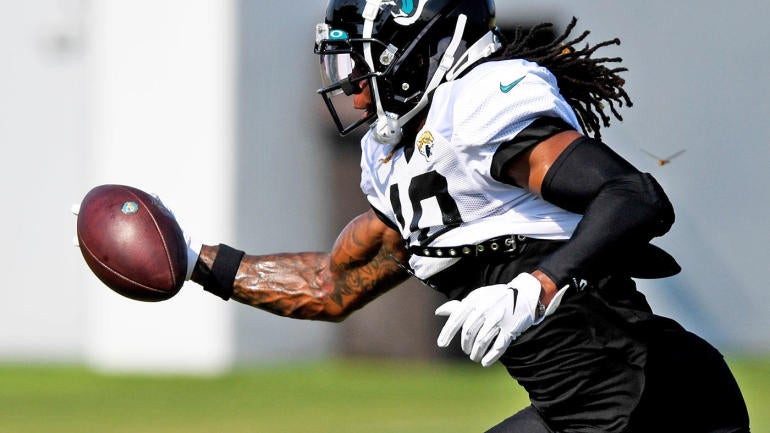
Rookies are always tough to trust. Their roles are undefined. We don't even really know if they can play. And yet, that risk if offset somewhat by the tantalizing upside — they can be some of the biggest breakouts each season. And in 2020, there are two major factors joining together to create a scenario where rookies are well-positioned to play a major role in deciding re-draft Fantasy leagues.
Reasonable expectations
The first thing to note about all rookies, and particularly wide receivers, is their roles tend to expand throughout the season. For every Terry McLaurin, Marquise Brown and T.J. Hockenson — all of whom kicked off Week 1 in 2019 with monster Fantasy totals — there are several others like A.J. Brown and Miles Sanders who aren't players you want in your lineups for a good chunk of the season. Of course, both Brown and Sanders went on to be huge pieces of many Fantasy title runs.
It is not uncommon to see rookies see limited roles early before playing full snap shares later. You can go through player pages on Pro Football Reference and verify this easily. Here are the weekly snap shares of the first- and second-round running backs and wide receivers (on separate tabs) over the past three years (data pulled from the great Premium Usage App over at RotoGrinders).
Nine of the 13 running backs taken in the first two rounds over the past three years played at least a 70% snap share in a game at some point in their rookie seasons. Nineteen of the 23 first-round wide receivers did.
I don't want to dive into this too much because there are all manner of unique circumstances. There are injuries; there's the trade that opened up a huge role for Nick Chubb; there's different usage stuff like Sony Michel only averaging a 35% snap share and not being one of those 70% weekly players at any point but also seeing over 200 touches as a situational runner. And this is only a three-year sample and it also leaves out many third-round rookies like McLaurin, Alvin Kamara and Kareem Hunt, who all played big roles.
The point is simply that teams that draft players high tend to use them, at some point. You can go beyond the scope of this table, back further or deeper into drafts to see this. You can also see here the increasing snap shares is an exceedingly common phenomenon, especially among wide receivers who first prove themselves in part-time roles then frequently earn full-time gigs in the second half of the season.
We can't and shouldn't expect many rookies to be strong full-season contributors, which is something that is often used to argue rookies aren't that useful for re-draft. And it is very much true that if you look at end-of-season stats only, you will typically find few rookies at the top of leaderboards, particularly for the slower-developing wide receiver position.
But Fantasy Football is a weekly game, and big performances in spurts and stretches can be more useful than a boring 16-game season from a solid RB2 or WR3, especially if those performances come late in the season.
The unique 2020 class
What immediately comes to mind about the 2020 class is the coronavirus pandemic, the shortened offseason, and concerns about how much usage these players will get. But this class was already unique back at the draft, before we had confirmed they would be missing big chunks of their first offseason.
That's because, while 13 running backs and 23 wide receivers went in the first two rounds over the past three years combined, six backs and 13 receivers went in those two rounds in 2020 alone. The whopping 19 total running backs and wide receivers that went in Rounds 1 and 2 was already going to flood Fantasy Football drafts with a ton of high-capital players from a promising class, too many for every one of them to get the attention they deserved.
My hypothesis is that a large subsection of the Fantasy Football world simply writes off rookies, at least on Draft Day. And given the way their snap shares rise and their end of season lines don't pop, you can't blame them. I would argue that in nearly any Fantasy draft, you'll find at least one or two people, and probably three or four, who are very unlikely to take a rookie at all. If you buy that, you understand the impact of 19 high-profile rookies entering a re-draft field in the same offseason — the people who are willing to target them can't possibly draft all of them. Some, like me, might try. But inevitably, Average Draft Positions are going to be pushed down overall.
Then you add in the shortened offseason. A narrative has arisen, probably correctly, that this will impact rookies negatively. We've heard coaches flat out discuss how difficult it is on rookies to get up to speed with the abbreviated practice time. Even with my personal rookie optimism, I fully expect there will be teams with positional depth that treat this year as a redshirt for more high-profile rookies than we see in a typical year.
And yet, rookies who can play often play early. Not all teams wait until Week 8 or Week 10 to play their rookies full time, and in many of those cases it would be hard to argue a few rotational preseason snaps made the difference for why teams thrust them into big roles. The McLaurin, Brown and Hockenson examples from 2019 are notable largely in that they weren't complete surprises but did in some ways come out of nowhere.
How to play it
How you approach the rookie class depends largely on your format and league size. In shallower leagues where it's more difficult to wait around for late-season production and players are likely to available on waivers through bye weeks, rookies won't be as much of a draft priority, but there is still an important point here to prioritize stashing them as we approach midseason. In deeper formats where long-term stashes are easier to come by, I'm lining up several rookies, many of whom come out as the best values on my board throughout the second halves of drafts.
What we have is a very deep rookie class at the top, depressed Average Draft Positions across the board, and the possibility that the overall production for this class might be limited a bit overall, especially early in the season. But with the depth of the class, it also feels almost impossible to imagine we won't have a few if not a half dozen or more rookies make significant Year 1 impacts. Guessing that all 19 of them will be at best mildly useful feels like a mistake.
While every year is different, the conditions surrounding 2020 drafts have set up to make this rookie class the clearest subset of late-round value. There are players with strong prospect profiles who got plenty of draft capital going overlooked in part because they were maybe the eighth or ninth player drafted at their position, and in part because of the shortened offseason.
Of course, we have to make decisions on Draft Day, and we can't draft every rookie. Knowing the broad expectations doesn't help us specify which are the best bets. So let's close by talking about the rookie class, highlighting a few that could make an especially big impact, including a couple outside the top two rounds.
Running backs
Clyde Edwards-Helaire (recent NFC ADP: 7.3) — Going in the first round of Fantasy drafts, Edwards-Helaire joins an explosive offense with continuity pretty much everywhere else, which should ease his transition.
Jonathan Taylor (ADP: 32.6) — An elite prospect athletically and in terms of production, Taylor is squeezed a bit but has massive upside behind a plus offensive line should opportunity open up.
Cam Akers (ADP: 52.4) — With teammate Darrell Henderson likely to miss the majority of the rest of camp, Akers could have a bigger Week 1 role alongside Malcolm Brown than previously thought.
D'Andre Swift (ADP: 56.5) — Beat reporter Dave Birkett told our Jamey Eisenberg on CBS Sports HQ this week to expect a 50/50 split between Swift and Kerryon Johnson, with Swift playing passing downs. That would be a solid early role, but Swift is banged up and needs to get healthy.
J.K. Dobbins (ADP: 69.0) — Perhaps the purest upside handcuff in all of Fantasy, Dobbins doesn't look likely to challenge Mark Ingram early, but the incumbent turns 31 in December and the rushing upside is huge alongside Lamar Jackson in this Baltimore offense.
Zack Moss (ADP: 97.2) — Lighting up camp, Moss is poised to have a solid early-season role and looks like a very strong value.
Ke'Shawn Vaughn (ADP: 124.3) — Vaughn unfortunately hit the COVID-19 list early in camp, pushing him further behind, but an adjusted ADP makes him an intriguing bench stash.
Antonio Gibson (ADP: 126.0) — Gibson has a limited track record but all the athleticism in the world. Having played more WR in college than RB, he profiles as a solid pass-catcher who could have monster upside in a three-down role if he's up for it.
A.J. Dillon (ADP: 143.1) — A slightly better tested athlete at the same weight as Derrick Henry, Dillon profiles as a high-end handcuff with some touchdown upside should a large role never materialize in a crowded backfield.
Joshua Kelley (ADP: 171.3) — Kelley is generating buzz at Chargers camp and has the size to fill the Melvin Gordon role alongside Austin Ekeler, making him a strong late-round target.
Darrynton Evans (ADP: 176.8) — Evans' star may have dimmed some with a poor camp, but there's still late-round handcuff potential for the 4.41 speedster who the Titans praised after the draft for his potential as a pass protector.
Even more to watch: Lynn Bowden, Eno Benjamin, Anthony McFarland, DeeJay Dallas
Wide receivers
CeeDee Lamb (ADP: 93.2) — Lamb has been a star at Cowboys camp, and the way Dallas leaned on 11 personnel last year, I expect he'll play plenty of snaps out of the gate. He's a strong option at his Round 8 ADP.
Jerry Jeudy (ADP: 107.1) — Praised for his route running, Jeudy joins a loaded passing game in an offense that might want to be run-heavy. He's not one of my favorite rookie values, but I'd be lying if I said I wasn't worried I'm overlooking him.
Henry Ruggs (ADP: 112.9) — Ruggs is another first-rounder joining an offense with plenty of weapons, and it seems every day there's a new Raider generating major camp buzz. Ruggs is another I'm torn on but wind up drafting infrequently.
Jalen Reagor (ADP: 114.6) — Part of why I don't wind up with Jeudy or Ruggs frequently is I prefer Reagor to both, and the former TCU star looks headed for a major early-season role catching passes from Carson Wentz.
Justin Jefferson (ADP: 129.4) — Jefferson has a strong profile and I expect big things from his career, but I'm wary of target volume behind Adam Thielen in Minnesota.
Brandon Aiyuk (ADP: 147.0) — The forgotten first-rounder, Aiyuk was coveted by the 49ers enough for them to trade up to grab him in the first round. Though Aiyuk has his own "mild" hamstring issue, Deebo Samuel's broken foot could open the door for a big Week 1 role.
Michael Pittman (ADP: 147.6) — A big outside receiver, Pittman gives the Colts a potential red zone replacement for Eric Ebron, but I'm concerned he could rotate some with Zach Pascal given Frank Reich liked to rotate his receivers frequently last year.
Laviska Shenault (ADP: 190.8) — I might as well have titled this "Why you should draft Laviska Shenault" because the idea a multidimensional early second-rounder with a strong production profile goes this late is preposterous. Then add in he's joining a team that should pass a ton, is building for the future, and both Dede Westbrook (27 years old) and Chris Conley (28) are impending free agents without an 800-yard season under their belts. If Shenault doesn't play a major role for Jacksonville at some point in 2020, I'll be absolutely shocked, and it could be as soon as Week 1. He's a target in the late rounds of every draft.
Bryan Edwards (ADP: 206.7) — Another underrated college producer, I wouldn't take Edwards over Ruggs in a vacuum, but considering cost, I'm far more likely to take a shot on the less-heralded Edwards.
Even more to watch: Denzel Mims, Tee Higgins, Chase Claypool, KJ Hamler, Van Jefferson, Antonio Gandy-Golden
So which Fantasy football busts should you completely avoid? And which running back going off the board early should you fade? Visit SportsLine now to get cheat sheets from the model that called Baker Mayfield's disappointing season, and find out.






